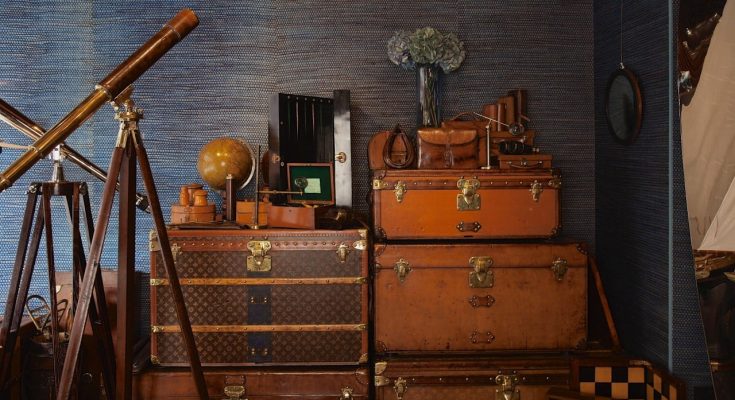Leather steamer trunks from the likes of Goyard, Au Départ, Moynat, Asprey and Finnigans bring to mind the golden age of travel, as well as those from Hermès and original trunk maker Louis Vuitton
Every year there are specific decorative pieces that the style set covet for their homes – be it a designer chair, table or piece of art. There’s one item, though, that continues to stand the test of time and trend cycles: a vintage luggage trunk.
“Vintage trunks evoke a sense of adventure and nostalgia, blending functionality with timeless style. Their enduring charm lies in their ability to conjure the spirit of travel while offering practical storage and durability,” says New York-based interior designer Melissa Bowers.
Once ubiquitous at flea markets around the world, vintage luggage trunks are now a common site at auction houses and antique stores, as homeowners and interior designers jostle among collectors to find unique pieces to display in their homes.

“Integrating a vintage trunk into an interior immediately adds a layer of history and individuality. The trunks also connect to the heritage and craftsmanship of a brand, and showcase the choice of the best-quality materials and the skills of their craftspeople,” says Tim Bent, owner of antique boutique Bentleys London.
“Plus the mixture of materials used – leather trim, brass locks, monogrammed canvases – provides texture, warmth and interest to a room,” he says.

Travelling trunks have been used for hundreds of years but the 19th century was considered the era of luggage innovation. Trunks became more popular among the elite while travelling by rail or steamship (that’s where the nickname “steamer trunks” comes from).
Over the decades different trunk makers – many of them hailing from France and the United Kingdom – would introduce new and practical designs, including flat top and monogram styles (circa 1896) by Louis Vuitton, and limousine and automobile luggage by another French brand, Moynat, in the early 1900s.
“These steamer trunks were made in a variety of forms to accommodate a variety of contents, from clothing to shoes to hats, and speciality cases often included liners and trays to fit their contents,” explains Anthony Barzilay Freund, editorial director and director of fine art at e-commerce platform 1stDibs.

“Many vintage examples from the early 20th century still retain their original owner’s marquage, often in the form of a monogram, and travel stickers from exotic destinations,” he says.
According to Bent, trunks from the 1880s to the 1930s are among the most covetable, with pieces from the 1920s – often considered the golden age of travel – in high demand for their beautiful patina and decorative appeal. Louis Vuitton and Goyard trunks are among the most desirable, although design buffs may also consider lesser-known brands like Au Départ, Moynat, Asprey and Finnigans.
While looks are important, practicality is key when choosing a vintage trunk for your home. Just because a piece was originally designed for a different era and purpose, doesn’t mean that it can’t be useful or function well in a modern home.

Given the timeless aesthetic and utilitarian design of vintage trunks, they can easily lend themselves to multiple spaces such as living rooms, libraries and dressing rooms.
“An antique steamer trunk could be used as a wardrobe in a small guest room by adding a hanging rail or shelves, or perhaps as a bar cabinet containing vintage glassware and favourite spirits in an alcove,” says interior decorator Lucia Tait Tolani.
“A vintage trunk offers both style and utility – it’s perfect for stashing blankets or other items while adding character to a room. If the client enjoys games, vintage travel trunks designed for chess or backgammon are a playful and functional addition,” adds Bowers.

They can be used as accent furniture – be it a pedestal where you can display photographs or memorabilia, a bedside table in a bedroom, or a side table in dens or media rooms. They also make extremely practical coffee tables – adding a glass top makes it even more functional while offering protection from potential damage.
While most vintage trunks are distinctive by nature, customising and personalising one can make it uniquely yours. As a final touch, Bowers suggests adding stripes tailored to the room’s colour scheme, while Tait Tolani recommends refurbishing the interior with your favourite fabric or a wallpaper.
“Add your own initials by having these painted on to the trunk just as they would have done originally. If a trunk has the original owner’s initials or name painted on it, adding your own is a nice way to ensure the continuity of the trunk’s story,” says Bent.
Expert tips on buying the perfect vintage trunk

First of all, details are important: provenance, condition, scarcity and originality all make a difference to a piece’s value. Check for marks of authenticity in the interior and on the exterior, including retailer’s stamps, maker’s marks and serial numbers.
Looks are important too: vintage pieces should show the patina you’d expect of something that old, while the decoration on monogrammed pieces should be crisp and clear.
Thirdly, choose a style that’s practical to ensure it will serve a purpose in any space in your home.
Above all, buy what you love and buy the best you can afford.



